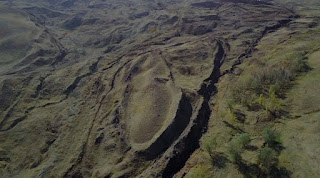The story of Noah's Ark, which is told in the Torah, the Bible, and the Koran, inspired some brave people to comb the slopes of Mount Ararat in Turkey, Armenia and its surroundings in search of traces of this legendary wooden ship.
In 1876, for example, British lawyer and politician James Bryce climbed Mount Ararat, where Bible records say the great boat stopped. He claims to have found a piece of wood that looks like a part of a ship.
Developments in technology and science make stories about the discovery of the more modern Noah's Ark occur more frequently. For example, the reports of an ophthalmologist who saw it in a rock formation on a mountain in the 1940s to the claims of an Evangelical priest who found petrified wood on the top of the mountain in the early 2000s.
But the search for Noah's Ark has riled academic archaeologists and Bible scholars alike. "No legal archaeologist has done this," said National Geographic explorer Jodi Magness, an archaeologist at the University of North Carolina at Chapel Hill, about the search to find evidence of Noah's Ark.
"Archaeology is not a treasure hunt. It's not about finding a particular object. It's a science where we ask research questions that we hope to answer by digging," he said, quoted by National Geographic.
Different evidence
"There does appear to be geological evidence that there was a major flood in the Black Sea region some 7,500 years ago," said National Geographic explorer Eric Cline, an archaeologist at the University of George Washington.
However, he continued, scientists disagreed on the extent of the event, just as historians of the time differed over whether accounts of the great flood were inspired by real life or not. He argues that it seems that floods were only experienced in different places and times, and that these events naturally entered into the world's oral and written knowledge.
Complicating matters further, scholars differ as to the exact location of Noah's Ark according to the Hebrew Bible. The Book says the ark came to rest "over the mountains of Ararat" which was located in the ancient kingdom of Urartu, a region that now included Armenia, and parts of eastern Turkey and Iran.
Both Cline and Magness say that even if artifacts from the ark have been or will be found, we can never conclusively connect them to historical events.
"We have no way of placing Noah, if he really existed, and the flood, if there was one, in time and space," Magness said.
"The only way you can tell is if you have authentic ancient inscriptions, and even then, such inscriptions could refer to another ark, or another flood," he continued.
Yet these questionable opinions have not stopped pseudoarchaeological-based searches that uphold the Bible as literal truth.
This search, which archaeologists say is futile, is often compared to adherents of "young-Earth creationism," the belief that despite evidence to the contrary, Earth is only thousands of years old.
Layman's expectations
Another problem, says Cline, is that the public has unrealistic expectations of the discipline of archaeology. In addition, popular media focuses more on the sensation of 'chasing' the discovery of evidence, rather than providing additional archaeological knowledge.
"We are not like Indiana Jones. This is a scientific procedure, it is laborious. But what excites us in this procedure may not excite other people," he said.
In his youth, says Cline, he spent a great deal of time and energy trying to disprove the Biblical evidence that supposedly captivated the public year after year.
Eventually, however, he quit and now focuses his time on his expeditions and translating his research for those who are willing to accept the results of the scientific process.
"Because most people only believe what they want to believe," he sighed.
Until now, for more than a century, people have been looking for ships that survived the flash flood. And archaeologists say it's a stupid task because they think Noah's Ark is impossible to find.


